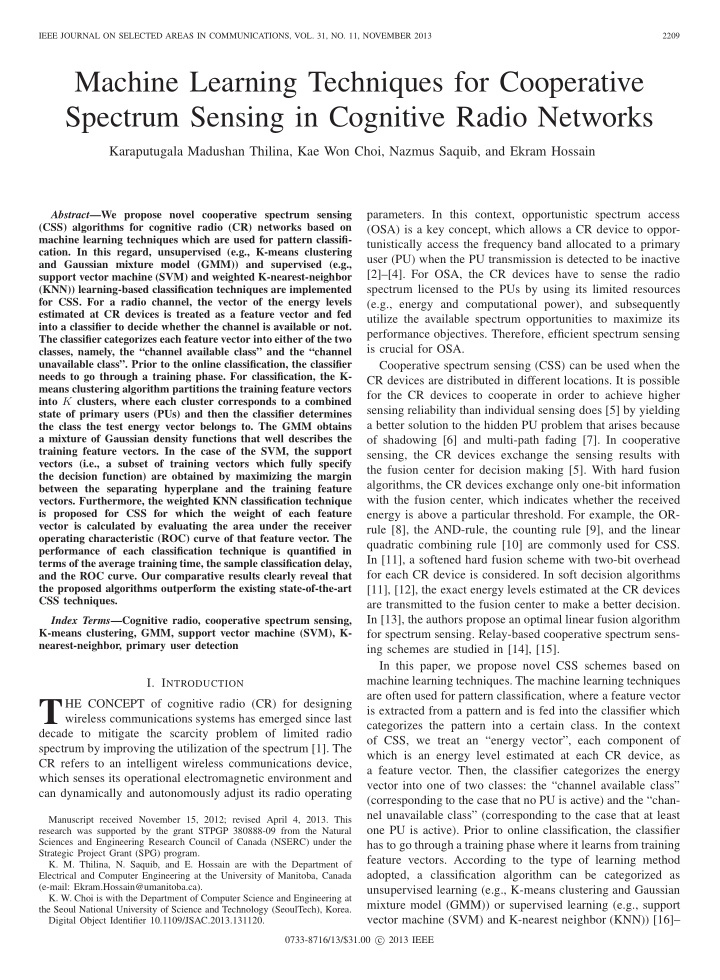



IEEE JOURNAL ON SELECTED AREAS IN COMMUNICATIONS, VOL. 31, NO. 11, NOVEMBER 2013 2209 Machine Learning Techniques for Cooperative Spectrum Sensing in Cognitive Radio Networks Karaputugala Madushan Thilina, Kae Won Choi, Nazmus Saquib, and Ekram Hossain parameters. In this context, opportunistic spectrum access Abstract —We propose novel cooperative spectrum sensing (CSS) algorithms for cognitive radio (CR) networks based on (OSA) is a key concept, which allows a CR device to oppor- machine learning techniques which are used for pattern classifi- tunistically access the frequency band allocated to a primary cation. In this regard, unsupervised (e.g., K-means clustering user (PU) when the PU transmission is detected to be inactive and Gaussian mixture model (GMM)) and supervised (e.g., [2]–[4]. For OSA, the CR devices have to sense the radio support vector machine (SVM) and weighted K-nearest-neighbor spectrum licensed to the PUs by using its limited resources (KNN)) learning-based classification techniques are implemented for CSS. For a radio channel, the vector of the energy levels (e.g., energy and computational power), and subsequently estimated at CR devices is treated as a feature vector and fed utilize the available spectrum opportunities to maximize its into a classifier to decide whether the channel is available or not. performance objectives. Therefore, efficient spectrum sensing The classifier categorizes each feature vector into either of the two is crucial for OSA. classes, namely, the “channel available class” and the “channel unavailable class”. Prior to the online classification, the classifier Cooperative spectrum sensing (CSS) can be used when the needs to go through a training phase. For classification, the K- CR devices are distributed in different locations. It is possible means clustering algorithm partitions the training feature vectors for the CR devices to cooperate in order to achieve higher into K clusters, where each cluster corresponds to a combined sensing reliability than individual sensing does [5] by yielding state of primary users (PUs) and then the classifier determines a better solution to the hidden PU problem that arises because the class the test energy vector belongs to. The GMM obtains a mixture of Gaussian density functions that well describes the of shadowing [6] and multi-path fading [7]. In cooperative training feature vectors. In the case of the SVM, the support sensing, the CR devices exchange the sensing results with vectors (i.e., a subset of training vectors which fully specify the fusion center for decision making [5]. With hard fusion the decision function) are obtained by maximizing the margin algorithms, the CR devices exchange only one-bit information between the separating hyperplane and the training feature with the fusion center, which indicates whether the received vectors. Furthermore, the weighted KNN classification technique is proposed for CSS for which the weight of each feature energy is above a particular threshold. For example, the OR- vector is calculated by evaluating the area under the receiver rule [8], the AND-rule, the counting rule [9], and the linear operating characteristic (ROC) curve of that feature vector. The quadratic combining rule [10] are commonly used for CSS. performance of each classification technique is quantified in In [11], a softened hard fusion scheme with two-bit overhead terms of the average training time, the sample classification delay, for each CR device is considered. In soft decision algorithms and the ROC curve. Our comparative results clearly reveal that the proposed algorithms outperform the existing state-of-the-art [11], [12], the exact energy levels estimated at the CR devices CSS techniques. are transmitted to the fusion center to make a better decision. In [13], the authors propose an optimal linear fusion algorithm Index Terms —Cognitive radio, cooperative spectrum sensing, K-means clustering, GMM, support vector machine (SVM), K- for spectrum sensing. Relay-based cooperative spectrum sens- nearest-neighbor, primary user detection ing schemes are studied in [14], [15]. In this paper, we propose novel CSS schemes based on machine learning techniques. The machine learning techniques I. I NTRODUCTION are often used for pattern classification, where a feature vector T HE CONCEPT of cognitive radio (CR) for designing is extracted from a pattern and is fed into the classifier which wireless communications systems has emerged since last categorizes the pattern into a certain class. In the context decade to mitigate the scarcity problem of limited radio of CSS, we treat an “energy vector”, each component of spectrum by improving the utilization of the spectrum [1]. The which is an energy level estimated at each CR device, as CR refers to an intelligent wireless communications device, a feature vector. Then, the classifier categorizes the energy which senses its operational electromagnetic environment and vector into one of two classes: the “channel available class” can dynamically and autonomously adjust its radio operating (corresponding to the case that no PU is active) and the “chan- nel unavailable class” (corresponding to the case that at least Manuscript received November 15, 2012; revised April 4, 2013. This one PU is active). Prior to online classification, the classifier research was supported by the grant STPGP 380888-09 from the Natural Sciences and Engineering Research Council of Canada (NSERC) under the has to go through a training phase where it learns from training Strategic Project Grant (SPG) program. feature vectors. According to the type of learning method K. M. Thilina, N. Saquib, and E. Hossain are with the Department of adopted, a classification algorithm can be categorized as Electrical and Computer Engineering at the University of Manitoba, Canada (e-mail: Ekram.Hossain@umanitoba.ca). unsupervised learning (e.g., K-means clustering and Gaussian K. W. Choi is with the Department of Computer Science and Engineering at mixture model (GMM)) or supervised learning (e.g., support the Seoul National University of Science and Technology (SeoulTech), Korea. vector machine (SVM) and K-nearest neighbor (KNN)) [16]– Digital Object Identifier 10.1109/JSAC.2013.131120. 0733-8716/13/$31.00 c � 2013 IEEE

Recommend
More recommend